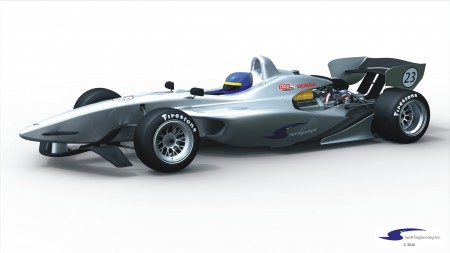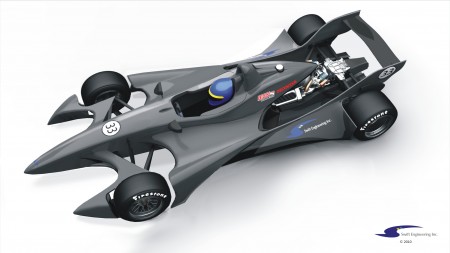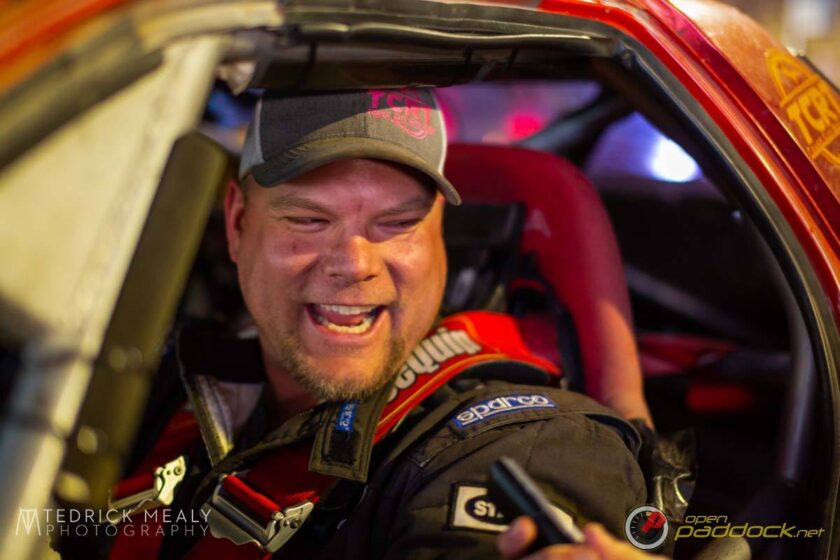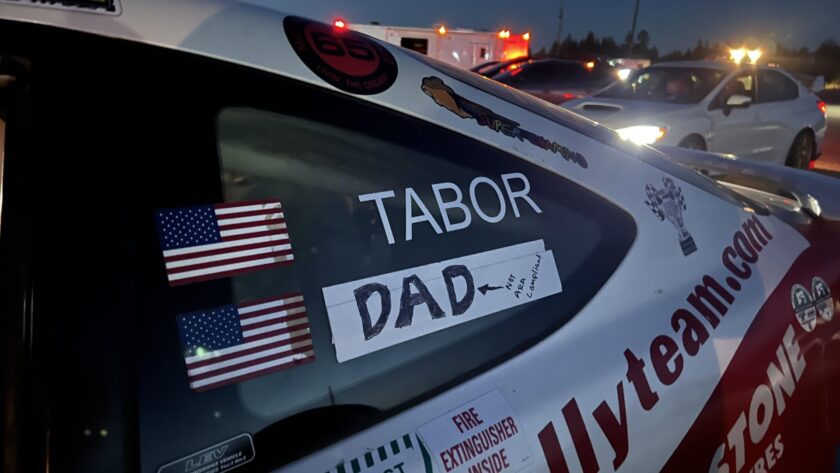Just after Lola released their minimal thoughts on the 2012 IZOD IndyCar Series chassis, Swift Engineering released a deluge of information regarding their project including several renderings of three different variations of their design. The exciting aspect of the Swift release is the level of technological innovation the company is bringing to the table. If Swift is able to accomplish even half of what they propose in their press release from today, then IndyCar is in for one hell of a ride!

American race car company, Swift Engineering, Inc. is proud to announce key motorsport partnerships with industry leading companies to further its bid to design and build the next generation race car chassis for the 2012 IZOD IndyCar Series ®.
“Given Swift is the leading US race car design and manufacturing company and our 27-year history was founded in motorsport, it is only natural that we aspire to partner with the nations’ premier open-wheel formula, the IZOD IndyCar Series,” Jan Wesley Refsdal, Swift’s president said.
Key business alliances have been cemented between Swift and Cray Inc. (The Supercomputer Company), Indianapolis-based Mark One Composites, Inc. and Cruden America, world leaders in motion racing simulators
“Individually, each one of these partnerships is critical to Swift’s continuing commitment to motorsport; however, collectively and in conjunction with one another they will help us set new industry standards in innovative design, manufacturing and support,” Refsdal stated.
Swift’s strategic industry partnerships were carefully selected and cultivated through a focused effort to realize the challenge the IZOD IndyCar Series has set for its next generation car.
Cray supercomputers will be used at Swift’s facility to further enhance its capabilities in Computational Fluid Dynamics (CFD), an important tool in the design and development of aerodynamic concepts. In conjunction with Swift’s existing on-site wind tunnel designs will be tested in accurate virtual models allowing for valuable driver feedback and performance data collection on Cruden’s state-of-the-art 3Ctr 6-DOF motion racing simulator which is soon to be operational at Swift.
“Speed-to-market is critical in any business, but probably more so in racing as the green flag doesn’t wait for anyone,” Refsdal said. “Rapid development is just as much about the speed and quality of the design process as it is manufacturing. We are evolving our four-year exclusive certified composite repair relationship with Mark One Composites, Inc. to provide further manufacturing and inventory support directly to teams from its Indianapolis-based facility.”
First of all, Swift automatically gets bonus points not for just promising to make the car in America, but for being an American company. The profits stay here rather than being headed off to Italy or England. Swift Engineering has also proven to be a forward-thinking and innovative manufacturer with their Atlantic Championship chassis, and the aggressively styled Formula Nippon chassis. So as with the three Dallara concepts, lets grade the three different Swift concepts on the merit of their raceability and their modern appearance.
Car #23 – Traditional Revolution:

Raceability: C
This design is about as safe as it gets from Swift. The front wings are swept instead of straight, but that’s really the limit of it. There’s nothing else within this design that really hints at greater raceability than the current Dallara. The one thing that Swift brings to the table that does have the potential improve the ability of cars to follow nose-to-tail more easily is their “Mushroom Buster” technology. The Mushroom Buster is simply a specific aero treatment rearward of the diffuser that cleans up the car’s wake thus improving the handling of a trailing car. This technology has been used with success in Swift’s 017.n chassis currently used in Japan’s Formula Nippon series.
“Whatever our final IndyCar concept design Swift will incorporate its pioneering new technology to improve passing, which we’ve named ‘Mushroom Busters’ in reference to the mushroom shape of a car’s aerodynamic wake signature,” states Swift chief designer, Chris Norris. “The ‘busters’ sweep up the wake behind the leading car, thus improving the handling of the following car. We have already effectively utilized Mushroom Busters in our Formula Nippon car design, the 017.n and believe we can now take this technology much further on the IndyCar.”
Aero improvements aside, the concern regarding side-by-side cars becoming involved in the type tread-to-tread collisions that we’ve seen cause drivers to end their race, and sometimes their season, upside down on the track, remains a concern with this concept. The sidepods and front wing allow ample access to the tread of both the front and rear wheels.
Modern Look: C+
Athough this concept does have an appealing asthetic, it doesn’t really come off as a truly modern, progressive design. Its a curvy version of the basic design philosophy that’s been a part of IndyCar racing since the early 1970’s when winged cars first started to break onto the scene. The exposed engine bay is a fun idea, “exposing the jewelery” as Swift puts it in their release, but that’s more retro than modern. While there is ample space for sponsorship decals, there’s not any significant difference in the available real estate than what we see currently. Overall, I’d rate this design as average.
Car #32 – Conservative Evolution:

Raceability: A-
Swift’s real strengths are borne out in their #32 and #33 concepts. These two designs use sidepods that extend from immediately behind the front wheel all the way to the front of the rear wheel, thus eliminating the risk of a tread-to-tread collision. This coupled with the Mushroom Buster technology greatly improves the ability of competitors to race nose-to-tail and side-by-side with a great deal of confidence and comfort. The exposed rear quarter of the rear tire does keep me from giving this design full marks, although the large nodules at the ends of the front wings forward of the front wheels do mitigate the risk of one competitor cutting down the rear tire of another. All in all, this is perhaps the best design we’ve seen yet regarding its ability to provide close, safe, and exciting racing.
Modern Look: B+
The #32 car has all of the qualities that the league has requested regarding the modern appearance, room for sponsorship, and recognizability of the cars. There is AMPLE surface area for the application of sponsorship decals, and those decals would be positioned to be easily visible by fans in the stands and TV cameras. The car has a decidedly sexy appearence and represents a significant move forward in design. There is only one problem, it looks like a prototype sports car rather than an open-wheel formula racer. This is a near stopper for me, personally. I still rate this design high given the criteria put forward by the league, but when I look at this design, I see an innovative LMP2 car that just happens to have a single seat rather than an IndyCar.
Car #33 – Ambitious Evolution:

Raceability: A-
This variation of the evolutionary design by Swift differs from the #32 design in how the sidepods are treated. As with the #32 car, the sidepods completely fill the gap between the front and rear wheels. As opposed to the #32’s sidepods whose outside lines flow straight along the length of the car, the #33’s sidepods flow inward toward the cockpit before moving back out to the rear wheels. This really doesn’t affect the raceability of the car, but it does improve the appearance as I’ll discuss below. The same exposure of the rear wheel seen in the #32 car also prevents me from giving full marks to the #33, but I’m not terribly concerned with it.
Modern Look: A
What a difference an indentation makes! Bringing the lines of the sidepod inward toward the cockpit moves this design from looking like an LMP2 car to a genuine futuristic open-wheel racer capable of recapturing the mystique and technical wow-factor of the Indianapolis 500. The car, while having all of the right visual cues that mark it unmistakably as an open-wheel car, has enough surface area to promote sponsors and allow the cars to be easily identified. The front-wing end nodules offer a unique spot for sponsors to get TV-time when the car is viewed from an in-car camera looking rearward. Right now, the only section of the Dallara that is viewable is the very narrow and highly inclined nose. About the only thing recognizable were the colours. In my opinion, Swift knocked it out of the park with this concept. It has all of the right design cues that mark the car immediately as an IndyCar, while at the same time bringing an aggressively progressive look that could revitalize the very tired and dated appearance the league has today.
More to come…
Stay tuned to Openpaddock.net as we’ll take a closer look at the Swift proposal, the corporate sponsors they bring to the project, and the technical innovations they could bring to the league.




I think the 23 car is so pretty! The 33 reminds me of a salad claw.
I’m sorry- I mean the 32 car is pretty. The 23 is MEH.
Let me start by saying that all of swift’s designs look better than anything Dallara released last week. I like elements from all 3 designs. I just don’t like the pointy bits in front of the tires on 32 and 33.
Beyond the visual appeal of all the swift designs, they look a whole lot more like finished cars instead of the dallara concepts.
Can’t wait to see what delta wing shows us tomorrow.
Like it or no, I suspect the front wing nodules are going to be an element in just about anyone’s design if the league really wants to preserve side-by-side racing while minimizing the risk of tread-to-tread contact.
My vote is for #32. Everything Swift has shown is better than Dallara and Lola to this point. Mainly because Lola has yet to release a picture…which is what I thought we were doing. Swift also incorporates some awesome ideas that I think can help the fans get into the action like never before. Almost like the cars let the fans interact with whats happening in the race. I agree with the Prototype look on both however….interesting designs.
[…] Monday, though the photos I saw only contained two. For a good write-up of all three designs, click here. (The third design is largely similar to the second, with a more radical front-end design. Thus, my […]
At first, I liked the 32 car. Then I read the comment about LMP2, and I couldn’t get that out of my head.
I hate the front wing on the 33 car. I want an Indycar, not the Mach3 or whatever from speed racer. Now, if you can put the nose from the 32 car on the 33, I think you’d have a winner.
I still think that Dallara will end up with the contract though. I think the exposed engine takes away some prime placement of sponsor logos. The yellow dallara with the angled sidepods seems to incorporate logo placement the best. And I think the importance of that aspect cannot be overlooked.